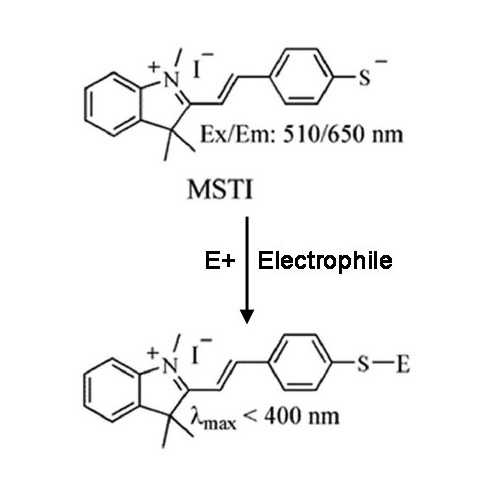MSTI Fluorescence-Based Thiol-Reactive Assay
The MSTI Fluorescence-Based Thiol-Reactive Assay allows for the quick identification of electrophilic and redox reactive compounds in screening libraries, streamlining the drug discovery process. The covalent binding of MSTI to electorphilic and redox reactive compounds causes a dramatic shift in its fluorescence at 650 nm that can easliy be measured.
Highlights:
- Nucleophilic thiol group easily reacts with electrophiles to form MSTI adducts
- Short, 30 min incubation time
- Optimized for 384-well format; also compatible with 1536-well format
- Far-red MSTI detection limits non-specific molecular interference
- Excellent reproducibility (Z' > 0.6) and standard deviation of <5% for each compound (using LOPAC library)
- Non-reactive, acetyl-MSTI precurser form allows for increased stability; Reactive MSTI is easily produced in situ
From the laboratory of Alexander (Leggy) Arnold, PhD, University of Wisconsin - Milwaukee.
 Part of The Investigator's Annexe program.
Part of The Investigator's Annexe program.
The MSTI Fluorescence-Based Thiol-Reactive Assay allows for the quick identification of electrophilic and redox reactive compounds in screening libraries, streamlining the drug discovery process. The covalent binding of MSTI to electorphilic and redox reactive compounds causes a dramatic shift in its fluorescence at 650 nm that can easliy be measured.
Highlights:
- Nucleophilic thiol group easily reacts with electrophiles to form MSTI adducts
- Short, 30 min incubation time
- Optimized for 384-well format; also compatible with 1536-well format
- Far-red MSTI detection limits non-specific molecular interference
- Excellent reproducibility (Z' > 0.6) and standard deviation of <5% for each compound (using LOPAC library)
- Non-reactive, acetyl-MSTI precurser form allows for increased stability; Reactive MSTI is easily produced in situ
From the laboratory of Alexander (Leggy) Arnold, PhD, University of Wisconsin - Milwaukee.
 Part of The Investigator's Annexe program.
Part of The Investigator's Annexe program.
| Product Type: | Small Molecule |
| Name: | Acetyl-MSTI |
| Alternative Name(s): | Acetyl-(E)-2-(4-mercaptostyryl)-1,3,3-trimethyl-3H-indol-1-ium |
| Chemical Formula: | C19H20NS |
| Molecular Weight: | 294.1 |
| Format: | Orange solid |
| Purity: | 95+% (HPLC) |
| Solubility: | DMSO, DMF, methanol, water (partially) |
| Spectral Information: | 1H NMR: (300 MHz, CDCl3, ppm) δ 8.25 (d, J =16.20 Hz, 1H, -CH=CH-), 8.20 (d, J = 7.9, 1H), 7.90(d, J = 16.4 Hz, 1H, -CH=CH-), 7.69?7.57 (m, 6H), 4.51 (s, 3H, -CH3), 1.89 (s, 6H, -CH3) |
| Storage: | -20C, protect from light |
| Shipped: | Ambient temperature |
Suggested Conditions: PBS (50 mM, pH 7.4, 150 mM NaCl), MSTI (30 µM), compound (100 µM), 5% methanol, 2% DMSO, and 0.01% NP40
Spectroscopic properties of the MSTI assay

(A) Absorbance spectra of acetyl-MSTI and MSTI. (B) Fluorescence spectra of acetyl-MSTI and MSTI.
Adapted from: McCallum MM, et al. J Biomol Screen. 2013, 18(6), 705-13.
Results of MSTI-LOPAC screen (1280 compounds)

The Library of 1280 Pharmacologically Active Compounds (LOPAC1280; Sigma Aldrich, St. Louis, MO) was used to determine the quality of the assay and the ability to identify compounds that are reactive toward nucleophiles mimicked by MSTI. Each LOPAC compound was measured at a concentration of 100 ?M in triplicate
Adapted from: McCallum MM, et al. J Biomol Screen. 2013, 18(6), 705-13.
- McCallum MM, Nandhikonda P, Temmer JJ, Eyermann C, Simeonov A, Jadhav A, Yasgar A, Maloney D, Arnold LA. High-throughput identification of promiscuous inhibitors from screening libraries with the use of a thiol-containing fluorescent probe. J Biomol Screen. 2013, 18(6), 705-13.
- Xu D, Bum-Erdene K, Si Y, Zhou D, Ghozayel MK, Meroueh SO. Mimicking Intermolecular Interactions of Tight Protein-Protein Complexes for Small-Molecule Antagonists. ChemMedChem. 2017 Nov 8;12(21):1794-1809. View Article
If you publish research with this product, please let us know so we can cite your paper.


